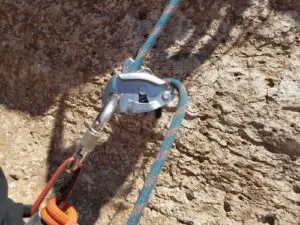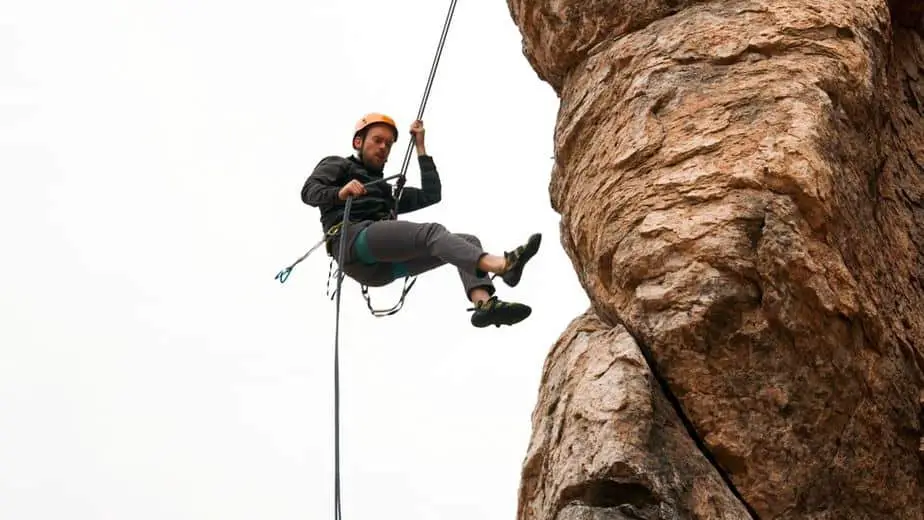If you’ve ever seen pictures of rock climbing, or walked through a place like Yosemite National Park, you might have wondered how rock climbers get back to the ground. Rock climbing is an exhilarating sport because of the adrenaline of ascending steep walls, but getting back down safely is obviously just as important as reaching the top.
Rock climbers get back to the ground by either descending the ropes they used to get up the rock (rappelling or lowering) or by hiking down a different, less steep, side of the rock. The preferred method depends on the features of the rock wall.
Once you start rock climbing, it’s important to be just as familiar and comfortable with descending a rock wall as you are with ascending it. While it might not seem as “exciting” as climbing up, getting back down to the ground can be a lot of fun and quite the challenge!
Many people even go outdoors to participate in hiking and rappelling without ever getting into actual rock climbing. Read on to learn more about the ways climbers get back down, and how to get involved in a safe and fun way.
Getting to the Ground After Rock Climbing
There are three main ways to get back on the ground after rock climbing: lowering, rappelling, and hiking. Sometimes descending a route requires using a combination of these techniques. What is each method and when do you use it?

Lowering
Lowering is probably the most common way that people get back to the ground, and is the recommended method for most single-pitch climbs (up to about 30m). To lower, a climber must feed the rope end through hardware at the fixed anchor, secure themselves to the end of the rope, and let their belayer lower them to the ground using a belay device.
This anchor will consist of “fixed” gear, or gear that is not meant to be removed. Sometimes this gear is a couple of hangers and chains bolted directly to the rock, or it could be a few pieces of webbing tied around a tree or other immovable object.
Oftentimes, climbers don’t go to the top of the actual rock wall or formation. They instead stop at an anchor that was attached to the wall by the climbers that established the climbing route.
It’s critical to recognize that you can only lower off of a climbing route if the fixed anchor is located at a height that is less than half the length of the rope being used, because the rope has to travel up to the anchor and back down to the ground to get the climber down safely. Always tie a stopper knot in the end of the rope just in case.
Additionally, there are infinite variations of how fixed anchors are set up and how they are designed to be used for lowering, so make sure you’re taught by an experienced partner or professional before attempting to lower. The downside to lowering, as explained below, is that it can wear out permanent anchors over time in popular areas.
Rappelling
Rappelling is the most common way for climbers to get down from a multi-pitch route (a climb that is longer than one rope length) that needs to be climbed in multiple sections. Like lowering, rappelling also uses fixed anchors in the rock, however the climber controls their own descent.
To rappel, the rope is threaded through the hardware at the fixed anchor. It’s important to thread the rope through to the halfway point to ensure that both ends reach the ground or the next belay station.
In nicer ropes, the middle point is often marked by either a dark stripe or a change in sheath pattern on the rope. As with lowering, always tie stopper knots in the ends of the rope so you don’t slide off the end.
Now, a climber can use a belay device and lower themselves down the rope to either the ground or the next fixed anchor. On a multi-pitch climb where everyone on the climbing team makes it up the wall, each climber must rappel the rope to the next anchor. Once the whole team is safe at the next anchor, the climbers can pull the rope down and start the process over again.
While you can rappel a single-pitch route, it’s often a technique saved for when two climbers have to descend the same route, as opposed to lowering, which only gets one climber down a route. Whenever possible rappelling, climbers should use a backup such as a fireman’s belay or ‘third hand.’
Lowering Versus Rappelling
There is a lot of debate in the climbing community as to whether climbers should rappel or lower for regular climbing. In a gym climbers always are lowered by their partners because the anchors are enormous metal bars that show little wear.
In the outdoors, weighted ropes can quickly wear through anchors with daily use at popular crags so it’s best to add your own quickdraws or carabiners to the anchor for lowering and have the last person rappel from the fixed gear.
Safety is also a factor, as many climbing accidents happen while lowering or rappelling . Make sure your partner always knows whether you intend to rappel or lower before you leave the ground, and confirm it before starting down.
. Make sure your partner always knows whether you intend to rappel or lower before you leave the ground, and confirm it before starting down.
Hiking
It might not seem obvious at first, but many climbers get back to the ground by hiking! Hiking off of a climbing formation can only occur if the rock feature has a less steep side, and if the climbs reach the top of the formation. While some climbing routes are set up to only allow you to descend by hiking off the top, others allow for multiple descent options.
For example, many climbers hike off the top of the famous rock formation El Capitan in Yosemite National Park, while others just climb some of the lower pitches, and then rappel back to the base of the rock.
Hiking off a rock is in many ways the safest and easiest way of getting down. However, it’s always important to remember that you’re hiking near cliffs, so staying on the designated hiking trail (if available!) is important at all times.
Descending in this way also means that you will need to carry a comfortable pair of approach shoes on the climb for the hike back down; nothing is worse than reaching the top of a high cliff and having to hike down in your climbing shoes!
Equipment Needed to Get Down From Climbing
Different ways of getting down require different gear, but nothing that you wouldn’t already start accumulating as a climber. Because each way of descending requires something slightly different, it’s important to decide ahead of time what method you’ll use.
Personal Anchor
It’s necessary to have a way of attaching yourself as the climber to a fixed anchor when you are getting ready to lower or rappel. You want your system for attaching to the anchor to be safe, easy, and manageable, as to eliminate confusion and risk. Here are a few options for a setting up a personal anchor:
- PAS: A PAS (personal anchor system) is a piece of gear specifically sold for this purpose. It has multiple interlocking loops of material that let you clip into the fixed gear at the anchor at various lengths. A PAS can be useful for both lowering and rappelling. In the past people used daisy chains, but these are not recommended anymore for safety reasons.
- Slings: Slings come in single or double lengths, and are more multi-purpose than a standard PAS. They can be shortened or lengthened by tying knots, and can be carried over the climber’s shoulder when not in use, thus freeing up space on the harness. Slings can be useful for both lowering and rappelling.
- Quickdraws: Quickdraws are the main gear used when sport climbing, but can be repurposed for use as a personal anchor if needed. Using quickdraws to attach yourself to the fixed anchors of a sport climb eliminates the need to carry any additional gear up a climb. Quickdraws are mainly useful when lowering. See also: How much weight can a quickdraw hold?

Belay/Rappel Device
Belay devices are what give you control over the rope. When you’re being lowered, the belayer will have the belay device. When you are hiking, you obviously don’t need one to get down! Rappelling is when every climber absolutely needs to carry their own belay device. Two common types of belay devices are:
- Assisted braking device: This style includes the popular Petzl GriGri which many newer climbers become familiar with at the gym. If you are rappelling using an assistant braking device, you MUST fix the rope so that you can rappel only one side of it without pulling the rope through the anchor. Some climbers do this by simul-rappelling
 , where two climbers rappel off opposite sides of the same rope.
, where two climbers rappel off opposite sides of the same rope.
- Tube-style device: When rappelling, a tube-style device like the classic Black Diamond ATC allows the climber to feed both halves of the rope through the device, so they can easily descend the rope by themselves. While a tube-style device doesn’t have assisted braking, rappelling on both sides of the rope adds significant friction into the system.
For more information on rappelling with a belay device and what we recommend, check out this article: Can I Rappel With a Belay Device?
Shoes
If you are rappelling or lowering off a route, you probably don’t need to carry an extra pair of shoes because you won’t be weighting your feet very much during the descent. However, if you’re hiking down, investing in a lightweight but sturdy pair of shoes is a good idea.
Hiking boots are often too heavy and bulky to carry up a climb, but a lightweight pair of running shoes, or purpose-built approach shoes, are a good compromise between comfort and weight for both the climb and hike down.
Related Questions
How Do Alpinists Get Down? Alpinists descend from a mountaineering expedition the same way they came up, hiking and rappelling down the ropes they fixed for the ascent. Alpinists may also ski down sections or may down climb other portions of the mountain.
Do climbers have to leave gear in order to get down? Sometimes in an emergency, climbers have to create their own fixed anchors in order to get down. However, in a normal lowering, rappelling, or hiking scenario, climbers don’t have to leave any gear! A safe climber will learn how to manage their ropes so that they can be used for the descent, but are still retrievable when the climber is safely down.
Do Free Climbers Climb Back Down? Most Free Solo Climbers walk off the top of their routes because down climbing is extremely difficult. Climbing down is often harder because the climber’s body obscures their view of the holds. If a walk off from the top is impossible, they will down climb easier routes.
Is getting down dangerous? When climbers get injured while getting down, it’s often because of a communication issue with their belayer or fellow climbers. Learning proper climbing commands, and discussing how you are going to get down before you start climbing, are imperative to safety. As always, seek instruction from an experienced partner or friend before attempting any of the techniques described above.
See Also:
How To Rappel Without Leaving Gear

